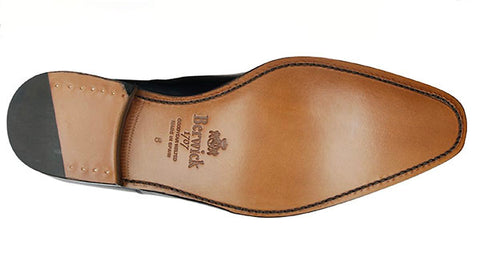SOLE TYPES
Leather soles

|
Compared to all the other types of soles, leather soles are long-lasting and heavy-duty. They can withstand harsh conditions as long as they are properly maintained. Another advantage is that they are breathable. Therefore, your feet don’t sweat when you are wearing leather shoes. Leather soles can also take up the foot shape of the wearer. These soles are ideal for formal shoes. |
Ridgeway soles
 |
Ridgeway soles are a variation of rubber shoes. As the name suggests, the soles have ridge channels and protruding lugs that give the wearer stability and traction. Just like rubber soles, ridgeway soles are durable and can be worn in any environment, including places with harsh weather conditions. They are also lightweight, which is an added advantage. |
Combination soles

|
Combination soles are made of two materials; leather and rubber. The entire sole is leather, but manufacturers attach the rubber to the heel and the front part of the shoe. The rubber makes the shoe durable. Additionally, it offers better traction. These soles are ideal for dress shoes. |
Wedge soles

|
Wedge soles are known for their spongy feel. Instead of a heel, the sole has a wedge that gradually becomes smaller towards the end. Wedge soles are non-slip in nature and have good traction. The downside with them is that they are not durable and get damaged easily. Manufacturers use wedge soles in both heritage-style boots and work boots. |
Commando soles
 |
Commando soles are known for their weather resistance, thanks to their thick lugs and rugged profile. The thick lugs give shoes traction and grip. Commando soles are thick and heavy, so shoes with this type of soles are clunkier. If you want lighter shoes, use a different kind of sole. These soles are pretty popular and are ideal for work shoes and hiking boots. |
Vibram soles
 |
Vibram® sole is not necessarily a sole type. It is a brand. They made a debut in the 1930s and are named after Vitale Brahmani, an alpine mountain climber and founder of the company that manufactures Vibram soles. Focusing on foot health, Vibram soles are durable, slip-resistant, and waterproof. They are ideal for walking and hiking shoes. |
Dainite soles

|
Dainite soles have been around for centuries. Just like ridgeway soles, dainite soles are a variation of rubber soles. They have a distinctive pattern with round recessed lugs. The lugs ensure that mud and stones don’t get stuck on the shoe sole. Shoes with dainite soles are very comfortable and durable. Most of them are thin and give shoes a more low-profile look. The main disadvantage with dianite soles is that they do not have enough grip, especially if one walks on mud terrain. These soles are ideal for dress shoes. |
Crepe Soles
 |
Crepe soles are made from natural latex “Crepe” rubber. They are known for their comfort and good-looking appearance. The comfort is a result of increased protection at the mid foot. The downside with crepe soles is that they are heavy. The material is also open-pore in nature, making it hard to remove any dirt or dust trapped in the sole. Crepe soles are ideal for modern boots. |
Flex walk Soles
 |
A white comfortable and highly flexible rubber sole They are known for their comfort and easy-on, easy-off, lightweight appearance. Used in the Berwick range as 'driving' or travelling shoes, these are ideal for warmer climates where a lightweight feel is required. |















